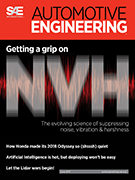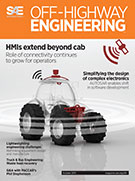Magazine

SAE Truck & Off-Highway Engineering: April 2023
2023-04-13
Headliners from Las Vegas Big reveals abounded at the triennial CONEXPO trade show. Following are some of the most notable unveilings from the desert. Cat doubles down on diesel with new C13D platform Deere pursues electric construction machines and charging infrastructure JCB debuts clean-sheet hydrogen combustion engine Volvo CE unveils electric asphalt compactor, announces NA arrival of L350H loader Honda reveals next-gen Autonomous Work Vehicle Deere 3D-prints fuel valves for tractors HP's binder jetting technology and GKN's manufacturing expertise helped John Deere realize its first 3D-printed metal part for mass production. Returning to the SAE presidency for 2023 Setting a "prudently aggressive" mindset in advancing SAE's goals in the mobility ecosystem.











